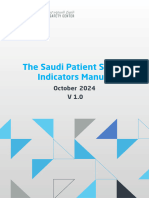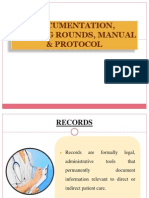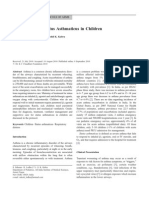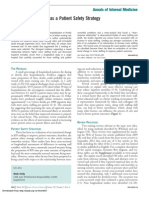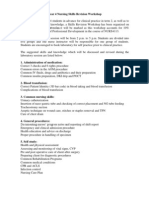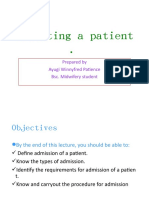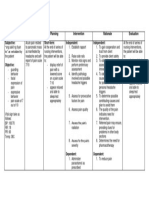Bedside Handover PDF
Bedside Handover PDF
Uploaded by
shutekiCopyright:
Available Formats
Bedside Handover PDF
Bedside Handover PDF
Uploaded by
shutekiOriginal Description:
Original Title
Copyright
Available Formats
Share this document
Did you find this document useful?
Is this content inappropriate?
Copyright:
Available Formats
Bedside Handover PDF
Bedside Handover PDF
Uploaded by
shutekiCopyright:
Available Formats
Standard Operating Protocol for Implementing Bedside Handover in Nursing
Prepared for
Professor Wendy Chaboyer Professor Anne McMurray Professor Marianne Wallis on behalf of Griffith University and Murdoch University 2008
Standard Operating Protocol for Bedside Handover
Published by the Research Centre for Clinical and Community Practice Innovation (RCCCPI) Griffith University Gold Coast campus, Qld, 4222
2008 Griffith University Suggested Citation: Chaboyer, W., McMurray, A., Wallis, M. & Chang, H.Y. (2008) Standard Operating Protocol for Implementing Bedside Handover in Nursing, Griffith University, Australia
About the Authors Professor Wendy Chaboyer RN BSc(Nu) MN PhD Director, Research Centre for Clinical and Community Practice Innovation, Griffith University Queensland Professor Anne McMurray AM RN PhD FRCNA Peel Health Campus Chair in Nursing, Murdoch University, Western Australia Professor Marianne Wallis RN BSc(Hons) PhD FRCNA Chair, Clinical Nursing Research Griffith University and Gold Coast Health Service District, Queensland Dr Hsiao-yun Annie Chang RN BN MN PhD Research Fellow, Research Centre for Clinical and Community Practice Innovation, Griffith University Queensland
The primary contact person for this project is: Professor Wendy Chaboyer Research Centre for Clinical and Community Practice Innovation Griffith University Gold Coast campus, QLD 4222 Tel: 61 (0) 7 5552 8518 Email: W.Chaboyer@griffith.edu.au
Standard Operating Protocol for Bedside Handover
Table of Contents Clinical Handover in Nursing Overview of Bedside Handover Detailed Description of Bedside Handover 1. Preparation 2. Introduction 3. Information exchange 4. Patient involvement 5. Safety scan Variation in Handover Information Summary References Appendix A: Summary of the Bedside Handover Research
Page 4 6 7 7 10 11 12 14 16 17 18 19
Standard Operating Protocol for Bedside Handover
Clinical Handover in Nursing
Clinical handover is defined as the transfer of responsibility and accountability for patient care from one provider or team of providers to another (Australian Medical Association, 2006). It is a key initiative to improve patient safety
(Australian Commission for Safety and Quality in Health Care ACSQHC, 2007; World Health Organization, 2007). A variety of handover techniques have been used by nurses, such as taped and verbal reports given in staff rooms. Recently, bedside nursing handover has emerged to improve the accuracy of handover communication (Lally, 1999; Philpin, 2006). It promotes a patient centered approach to care (Rutherford, Lee & Greiner, 2004), and with patient contribution, it can improve patient safety and increase both patient and nurse satisfaction. This document describes a Standard Operating Protocol (SOP) for bedside handover in nursing. Importantly, while patient information is handed over at the bedside, unit information such as sick leave and in-services, is handed over away from the bedside, generally before or after the bedside component of the handover.
This SOP for bedside nursing handover is based on our research conducted in six wards of two hospitals in Queensland and Western Australia in 2007-2008. We observed over 500 bedside handovers and interviewed over 30 nurses. Our research shows that when a change management process is used, bedside handover can be successfully implemented in a variety of clinical situations. What appears to be key is nurses recognition that bedside handover facilitates more accurate information exchange, and provides nurses with the opportunity to work in partnerships with their patients. Also important is the recognition that bedside handover does not extend the time taken for handover, with about 1.5 minutes on average spent at each bedside. In fact, it actually saves oncoming nurses time because the handover is comprehensive, and prompted by visualising the patient, it assists in identifying care priorities. Oncoming nurses do not passively receive information; they are active participants, questioning outgoing staff and patients and leading the safety scan and medication review, thus promoting patient safety. Finally, the legitimate concerns related to patient
Standard Operating Protocol for Bedside Handover
privacy and confidentiality can be easily managed. In fact, our medical
colleagues have long shown that while concerns surrounding sharing patient information in multi-bed rooms should not be ignored, numerous strategies can be used to ensure sensitive patient information remains confidential. Our
research has shown that sensible and sensitive approaches to sharing confidential patient information are easily undertaken. A short summary of this research is provided in Appendix A.
This SOP for bedside nursing handover is intended to act as a resource for its implementation. First, an overview of bedside handover is provided. Second, a detailed description of the steps in the process is given. Finally, some examples of the variations to this process are briefly outlined. We have provided direct quotes from our research in sidebars, to show what nurses who participate in bedside handover think about it. We use the stars icon to highlight tips and use a tick to indicate particular issues that should be considered. Finally, boxes are used to display examples. These various symbols and their meanings are displayed below. Direct quote from the research
Tips
; Tick
Particular issue to be considered
Example
Prior to implementing bedside handover in nursing, it is important to consider why such a change will be beneficial, what barriers there may be to its adoption, and how a change management strategy should be developed. Further,
Standard Operating Protocol for Bedside Handover
bedside handover focuses on sharing patient information but unit information will be shared away from the bedside.
Overview of Bedside Nursing Handover
Figure 1 provides a schematic overview of the bedside handover process. Each of the five steps is detailed in the following section. 1. Preparation
Patient allocation Update handover sheet Inform patients Request visitors other than family to leave
; Bedside
Patient is comfortable to proceed with handover Family are present with patients consent Privacy is secured
2. Introduction
Outgoing staff greet patient Outgoing staff introduces oncoming staff to patient
; Convene Participants
Outgoing team leader Incoming staff Patient and family Shift co-ordinator
3. Information Exchange
Clinical condition Tests and procedures ADL assistance Discharge planning Queries from oncoming staff
; Acronyms to Prompt Information Sharing
Patients condition changes Changes in patient management Staff unfamiliar with patient
4. Patient Involvement
Ask patients if they have questions or comments Invite patient to confirm or clarify information
; Confidentiality
Sensitive information is shared in a private location Sensitive information may be recorded on the handover sheet
5. Safety Scan
Call bell within reach Equipment functioning Access to mobility aids Tubes and lines checked Medication chart reviewed Bedside chart review
Final Questions
Next patient
Figure 1: Schematic Overview of Bedside Handover
Standard Operating Protocol for Bedside Handover
Detailed Description of Bedside Nursing Handover
Nursing handover is the primary method of sharing patient information between shifts and ensuring continuity of care from shift to shift. Nursing handover at the bedside should be an interactive process, providing opportunities for input and questions from oncoming and outgoing as well as for obtaining the patients viewpoint. In particular, bedside handover ensures that patients remain at the centre of their care. In the research that underpins this SOP, team nursing was used with 2-3 teams of nursing staff per ward. Handover occurred between these smaller teams; not as a whole of ward handover. Although the principal intention of handover relates to sharing patient information, other functions we found included opportunities for teaching, and building group cohesion. This section provides a detailed description of how to undertake bedside nursing handover, following the schematic overview of bedside handover (Figure 1). The headings in this section follow the five steps in this overview including: 1) Preparation; 2) Introduction; 3) Information exchange; 4) Patient involvement; and 5) Safety scan.
Bedside handover, I am 110% for it, its the best thing ever
1. Preparation
There are four aspects to the preparation for bedside handover: 1) Staff and patient allocation; 2) Updating the handover sheet; 3) Informing patients; and 4) Family and Other Visitors.
Standard Operating Protocol for Bedside Handover
1.1 Staff and Patient Allocation
Bedside handover has been used successfully where team nursing is practised. A team nursing approach provides care for a specified group of patients by a designated team of nursing staff such as registered and enrolled nurses, and assistants all working together. There are no special considerations for staff and patient allocation when bedside handover is used. That is, the wards standard practice should be followed.
Handover at the bedside is good because the patients then see that you do know about them which gives them more confidence in your ability to look after them and also they can be involved.
1.2 Updating the Handover Sheet
A computer generated electronic handover sheet that contains information about all patients on the ward is a key tool that is required when bedside handover is implemented. The handover sheet allows nurses to gain an understanding of the patients on the ward that they do not receive bedside handover on. It is therefore crucial that this handover sheet is updated every shift. The information that is contained on this sheet may include: age, gender, admitting diagnosis, medical history, social history, changes in condition, pending tests and results, discharge planning, and sensitive information such as HIV status. Box 1 contains one example of a
handover sheet. The handover sheet can be tailored to the needs of the particular ward.
Box 1: Example of an electronic handover sheet
Bed Pt Dr Age Dx Admission Date Notes
01
Annie Griffith
Smith
65Y
Cellulitis L Leg
16/06/200 8
04
Laoi Chapell
Jones
60Y
Uncontr olled A Fib
10/06/200 8
Hx: IHD,PVD, HTN, Lives alone. Multiple admissions for leg ulcers. Self- discharges on occasion; awaiting social work assessment; needs 1 assist to help mobilise. Hx: COPD, CCF. lives alone, transferred from ICU 11/06 after cardioversion; VS stable; expected D/C 14/06
Standard Operating Protocol for Bedside Handover
When team nursing is practiced, the team leader, not the shift co-ordinator should have ultimate responsibility to ensure the handover sheet is up to date and accurate.
Giving 100% attention to H/O shows the patient that I care for them and that theyre important.
It is helpful to have components of the health record, such as the observation record, care plan, medication record, fluid balance sheet and risk assessment forms such as falls or pressure ulcers at the patients bedside. This bedside chart may be placed on a clip board hanging from the foot of the patients bed and should be checked for completeness prior to handover.
1.3 Informing Patients
Toward handover time, team members should inform patients that the handover will begin shortly. This signals to patients that the staff caring for them will soon change and allows patients to prepare for the handover, including what contribution they may want to make.
Patients are often a really valuable source of information
1.4 Family and Other Visitors
With the patients permission, family members are allowed to stay at the patients bedside during the handover. Other visitors should be asked to leave the room during the handover.
; Bedside
Patients are comfortable prior to beginning the handover. Families are present with the consent of the patient. Visitors are asked to leave the bedside.
Standard Operating Protocol for Bedside Handover 2. Introduction
The team leader of the outgoing team should lead the handover, with the remaining outgoing team members available to answer call bells and provide other care. Because the outgoing team leader has already built a rapport with the patient, they should introduce the oncoming team members to the patient and family. The outgoing team leader should ensure a personable approach is maintained. The shift co-ordinators attendance at bedside handovers varies according to whether they have a patient load. If they are allocated a patient load, they attend their teams handover. Then, either before or after this, they receive handover from either the shift coordinator of the outgoing staff or the other team leaders of the oncoming teams. At times a shift coordinator to shift coordinator handover will occur away from patients bedsides, and will include managerial and other unit related information.
; Convene Participants for Handover
The team leader of the outgoing team leads the handover, with other outgoing team members available to provide care. All of the oncoming team members attend the handover. The shift co-ordinators attendance at bedside handovers varies according to whether they have a patient load. Staff commencing outside of the bedside handover periods use the handover sheet as a guide and provide care under the direction of the team leader. Patients may be given the option for the handover to occur away from the bedside, especially if they are located in a room with several beds per room.
If theyre [patients] uncomfortable, obviously you dont have to do theirs [the handover] at the bedside, you can do theirs outside the room or in the nurses station.
10
Standard Operating Protocol for Bedside Handover 3. Information Exchange
Accurate and detailed handovers are crucial to ensure oncoming staff can provide safe care. In general, the information handed over at the bedside does not differ to what would be exchanged when other forms of handover are used, however staff should be cognisant of the language they use, limiting medical jargon when possible. A real safety benefit of bedside handover is the fact that visualising the patient may prompt nurses to recall important information that should be handed over and it may also trigger oncoming staff to ask additional questions. Further, patients have the opportunity to clarify content. Outgoing staff should strive to communicate information accurately, succinctly and professionally. Box 2 contains the information that is generally shared during the handover. Box 2: Example of information shared during bedside handover 1. Date and reason for admission 2. Relevant medical history including new referrals 3. Investigations 4. Treatments and patient response 5. Nursing care plan and patient response 6. Safety concerns 7. Discharge planning 8. Recommendations for future care
You can get a lot more observation and draw a lot more information when you actually look and see for yourself.
; Acronyms to Prompt Information Sharing
A number of acronyms have been developed to provide structure to the handover and help remind nurses about the information they should share during handover. Using these acronyms may be particularly important when:
11
Standard Operating Protocol for Bedside Handover
The patients condition changes Changes in the proposed nursing or medical management of the patient Staff are unfamiliar with the patient
Two acronyms are displayed in Box 3. Box 3: Example of two acronyms to prompt information sharing during bedside handover
SBAR
S: Situation chief complaint, current status B: Background previous history A: Assessment result of assessment, vital signs and symptoms R: Recommendation suggested and anticipated changes, critical monitoring
ISOBAR
I: Identify the patient and staff S: Situation and status O: Observations, MET calls etc. B: Background A: Accountability R: Risk management
Gossip and derogatory comments have no place during bedside handover. Language should be maintained at a professional and reasonable level.
I think the information that were handing over is often a lot more
professional, and youre getting a more comprehensive picture of whats happening.
4. Patient Involvement
In a patient-centred approach to care, it is important to involve the patient in handover. Patients should be provided with opportunities to seek clarification, ask questions and confirm information. Specifically, the outgoing nurse who is giving the handover should invite patients to comment or ask questions during the handover. Family members should be invited to participate in the handover with the patients consent. Patient groups that may not participate in handover include those who are:
12
Standard Operating Protocol for Bedside Handover
Asleep; Confused; Comatose; In isolation; Have difficulty communicating in English Other conditions that precludes participation;
If you speak to them [patients] during the process they feel like theyre involvedthey know straight away whos looking after them, they can put a name to the faces.
; Confidentiality
Patient confidentiality can be an issue if not adequately addressed, but it has also been overcome by our medical colleagues. A number of strategies can be used to ensure that patient confidentiality is maintained. For example: Sensitive information can be shared away from the bedside Staff should lower their voices when sharing sensitive information Sensitive information may be recorded on the handover sheet Sensitive information may include: Blood tests of a diagnostic nature (eg. HIV positive); Communicable disease information (eg. Hepatitis); Psychiatric issues (eg. suicidal, ethanol abuse) Not for resuscitation orders, Some family issues (eg. conflicts, domestic violence); Anything else patients identify they wish to be held in confidence.
Bedside handover lets patients know that theyre actually valued and it also gives the family an opportunity to participate as well.
13
Standard Operating Protocol for Bedside Handover 5. Safety Scan
During the handover, undertaking a safety scan promotes patient safety and appears to be one significant benefit of bedside handover. This scan includes the environment, the patient and the bedside chart.
5.1 Environmental Safety Scan
During the bedside handover, oncoming staff should undertake a safety check of the patients environment and equipment. Key items to consider are: The patients call bell is in reach; Suction, oxygen or other equipment are in working order and easily accessible; Dressings, drains, intravenous fluids and infusion pumps are secure and correct; The general tidiness of the area is conducive to safe mobility and ease of access and Any other checks that may be specific for that patient (eg. use of bed rails, height of the bed etc)
5.2 Patient Review A physical review of the patient may include observing catheters, drains and dressings. This review will allow outgoing staff to better explain problems or issues.
You generally find out a clearer picture once you actually go and talk to the patient yourself.
5.3 Bedside Chart Review
Near the end of the bedside handover, the oncoming team leader should review the bedside chart to identify additional safety concerns such as medications not signed for and changes in vital signs. The following sheets should be checked: care plan, observations (including vital signs),
14
Standard Operating Protocol for Bedside Handover
medication sheet, fluid balance sheet, any risk assessments such as falls or pressure ulcers. A bedside chart review provides a check of the care and medications that have been given, allowing outgoing and oncoming staff to discuss discrepancies or other issues.
Any mistakes are picked up straight away and theyre not carried on for the next couple of shifts.
; Final Questions
The oncoming staff should ask questions if further clarification is needed prior to leaving the patients bedside. Upon the completion of handover, outgoing staff should ensure that all confidential information has been passed on to the next shift.
If you engage the patients properly they give you good feedback from it, so therefore you feel better about everything.
A case example of bedside handover is provided in Box 4.
Box 4: Example of a Medical Patients Handover
Preparation RN Annie is a team leader. She reads the patients medical record before handover ensuring she is up to date with the medical decisions recorded in the doctors notes. She checks the bedside chart to ensure everything in the handover is accurate. Towards handover time, RN Annie gets the team members together to update the handover sheet. Annie tells the patient that handover will occur shortly, ascertains whether the patient wishes family to be present during the handover and ask non-family members to wait outside for a short while. All oncoming staff members are given a handover sheet. Introduction Mr. Smith, good afternoon, This is Sylvia, a RN, Cindy an EN and Susan, a nursing assistant. They will be taking care of you in the evening shift. RN Annie keeps her voice low but ensures that Mr. Smith and the oncoming staff can hear her. S: Mr. Smith came to the ED complaining of chest pain and shortness of breath. He was placed on O2 via nasal cannuala at 2l/min. He is on an antihypertensive, aspirin and a beta blocker (medication record shown to Nurse Sylvia). B: Mr. Smith has a history of chest pain over the past two days, which radiated down
Information exchange S: Situation B: Background
15
Standard Operating Protocol for Bedside Handover
A: Assessment R: Recommendation s his left arm. He has prn anginine at home. Over the past 6 months he has had several bouts of chest pain, and has been followed by his GP. Today, prior to being admitted, he developed chest pain but is currently pain free. A: This afternoon, his BP=130/86, Temp=38.0 and Heart Rate=76. He is currently pain free. R: Doctor Jones has arranged a cardiac echo for him. He has had an ECG today with no significant changes. Blood tests all attended and are waiting on results. RN Sylvia then asks about any treatment for his raised temperature and also questions about mobility. Nurse Annie responses: Dr. Jones is aware and has asked to be notified if it goes above 38.5. Mr. Smith can mobilise with assistance but only toilet and shower privileges. Patient involvement Nurse Annie asks Mr. Smith, have you been to cardiac echo? Mr. Smith says yes. Nurse Annie then asks, Did the doctor say anything to you? Mr. Smith says, She said, I may need a cardiac catheter Nurse Sylvia then asks Do you have any questions Mr. Smith? Mr. Smith states Can you find out if I need the cardiac test? EN Cindy undertakes a safety check of the equipment, including checking that the call bell is within reach, the suction and oxygen equipment are functioning. RN Sylvia and RN Annie review the bedside chart, checking the following: care plan, observation chart, medication chart, fluid balance chart, and the pressure ulcer assessment. RN Sylvia asks Has Mr. Smith needed any GTN recently? RN Annie said Oh, I forgot, Mr. Smith had chest pain around 9:30 am and took one GTN sublingually. This was relieved within 5 minutes. Yes. I will sign for the med now. Handover completed Confidentiality Nurse Annie said Mr. Smith, we have finished the handover, do you want to add anything before we leave? Mr Smith said, No, Ill wait to hear about that other heart test. After finishing the handover in the 4 bed room, all staff went out the room in the corridor, nurse Annie said I have to hand over some sensitive information related to Mr Smith; he has hepatitis C, so make sure you adhere to universal precautions when undertaking his care.
Safety scan
Variations in Handover Information
A number of variations may be adopted when undertaking bedside handover. While it is not possible to list all of these variations, some options include: Ward variation The specific content of the handover may differ among various types of wards such as oncology wards and rehabilitation units. Information on patient transfers may differ on medical and surgical wards, particularly where patients are expected from theatre or postanaesthetic units. There needs to be a consistent way to convey unit related information such as sick leave and in services, to ensure all
16
Standard Operating Protocol for Bedside Handover
staff are informed about this information. Adding a section to the handover sheet is one means of conveying information in a written format. A second strategy is for all oncoming staff to receive a brief unit update as a group at the start of their shift, prior to beginning bedside handover. Patient variation Some patients may not want to be involved in bedside handover. Their wishes should be respected and an alternative approach to the handover should be undertaken. For example, the handover could occur in the hallway, just outside the patients room. Staff variation - Inexperienced or less familiar staff, such as casual or agency staff, may require more in-depth explanations in order for them to comprehend the handover information. When all receiving staff are familiar with the patients history, diagnosis and current condition, some aspects may be excluded during handover focusing instead on recent and anticipated changes. The extent to which information is excluded should always be considered in relation to the potential risk this exclusion may have. In other areas, redundancy of key information (i.e. repeating of information), has been shown to improve safety. Shift variation Night shift handover (or other handovers when the patient is asleep) may occur in the corridors, with a quick walk around undertaken during the handover. If a staff member comes on duty at a different time, they may receive handover from the team leader not at the bedside, however, they would then attend the next bedside handover.
Summary
Effective communication amongst health professionals is the key to ensuring quality care in clinical practice. This SOP for implementing bedside nursing handover provides a toolkit for those interested in adopting bedside handover. Grounded in a patient-centred approach to nursing care, bedside handover is one nursing activity to promote continuity of care. The research upon which
17
Standard Operating Protocol for Bedside Handover
these SOPs are based uncovered many benefits of bedside handover for both staff and patients. Importantly, it promotes patient participation in their care and helps nurses gain a better understanding of their patients and priorities for their work. The handover process documented here has considered preparation, introduction, information exchange, patient involvement, safety scan and examples of variations that may influence the handover. This toolkit is designed to provide guidance to nurses wanting to implement bedside handover.
Bedside handover streamlines handover and makes the patients more involved in the handover.
Makes patients feel theyre actually part of the processthat theyre actually valued, and gives the family an opportunity to participate.
References
Australian Commission on Safety and Quality in Healthcare (2007). The Commission's Nine Priority Programs. Canberra: Australian Health Ministers' Conference on 24 July 2007. http://www.safetyandquality.org/internet/safety/publishing.nsf/Content/programs -lp Australian Medical Association (2006). Safe handover: Safe patients; guidelines on clinical handover for clinicians and managers. http://www.ama.com.au/web.nsf/doc/WEEN-6XFDKN/pdf (accessed June 2007). Lally, S. (1999). An investigation into the functions of nurses communication at the inter-shift handover. Journal of Nursing Management, 7, 29-36. Rutherford, P., Lee, B. & Greiner, A. (2004). Transforming care at the bedside. Cambridge, Ma: Institute for Healthcare Innovations. Philpin, S. (2006). Handing Over: transmission of information between nurses in an intensive therapy unit. Nursing in Critical Care, 11(2), 86-93. World Health Organization (2007). Communication during patient hand-overs. Patient Safety Solutions, 1(3). Accessed from http//www.who.int/patientsafety (26 May, 2008).
18
Standard Operating Protocol for Bedside Handover
Appendix A Summary of the Bedside Handover Research W. Chaboyer, A., McMurray, M. Wallis Introduction: The aim of this study was to describe the structures, processes and outcomes of nursing bedside handover in medical and surgical wards in two hospitals. Methods: A case study method with nested cases on six wards was used. Data collection included observations for five days per ward and in-depth interviews with nursing staff. Thematic content analysis and descriptive statistics were used to analyse the data to identify structures, processes and outcomes of bedside handover. Results: A total of 532 bedside handovers were observed and 34 nurses interviewed. Structural components of the handover are described in Table 1. In terms of processes, both sites used a computer generated handover sheet. At one site, SBAR was used to convey information and safety and medication checks were included. Confidential information was shared away from patients and visitors, often in hallways. Bedside handover improved the quality of information, provided opportunities for teaching and saved time. It allows senior nurses to model behaviours that promote patient safety and facilitates the development of critical decision making skills among nursing staff.
Table 1: Overview of Bedside Handover Structures
Structure Staff Description Team nursing used to deliver care. Handover generally attended by team leader of the outgoing staff and all members of the receiving staff. Shift co-ordinators attendance at bedside handovers varies according to whether they have a patient load. Shift co-ordinator either attends one team handover and receives short report from other team leaders or received a shift co-ordinator to shift co-ordinator report away from the bedside. Patients who generally do not participate in the handover include those that are: asleep, hard of hearing, confused, comatose, have difficulty communicating in English and/or in isolation. Computer generated sheet, updated regularly, contains information about all patients on the ward. Individual patient information includes: age, gender, admitting diagnosis and medical history, social history, discharge planning, changes in clinical condition, and sensitive or confidential information such as HIV status. Oncoming staff writes their plans for patient care for the shift on this sheet, noting required care, observations, tests etc. Components of the health record, consisting of the observation record, medication record, fluid balance sheet and risk assessment forms (falls, pressure ulcers) are at the bedside for use during the handover.
Patients
Handover sheet
Bedside chart
19
Standard Operating Protocol for Bedside Handover
Conclusion: Implementing bedside handover is one strategy to transform nursing care at the bedside. Clinical leadership and a focus on patient centred care are two key elements for successful implementation of bedside handover.
20
You might also like
- The Saudi Patient Safety Indicators Manual-1Document56 pagesThe Saudi Patient Safety Indicators Manual-1Nesrin M.AliNo ratings yet
- Nursing Care Plan For Inguinal HerniaDocument5 pagesNursing Care Plan For Inguinal HerniaIv'z Tandoc67% (6)
- Basic Life Support and Advanced Cardiac Life Support: Knowledge of Medical Students in New DelhiDocument9 pagesBasic Life Support and Advanced Cardiac Life Support: Knowledge of Medical Students in New DelhiSriatiNo ratings yet
- 1.2 Policies On Registration of A PatientDocument4 pages1.2 Policies On Registration of A PatientSwati Bajpai50% (2)
- Restraint CompetencyDocument6 pagesRestraint CompetencyFrederick RyanNo ratings yet
- NSC ManualDocument263 pagesNSC ManualshutekiNo ratings yet
- Immediate Post-Operative CareDocument4 pagesImmediate Post-Operative CareHeidi Avediz Del Fuerte100% (1)
- Nipro Surdial 55 Plus Machine PDFDocument13 pagesNipro Surdial 55 Plus Machine PDFSergio Ledezma100% (8)
- The COAT & Review Approach: How to recognise and manage unwell patientsFrom EverandThe COAT & Review Approach: How to recognise and manage unwell patientsRating: 5 out of 5 stars5/5 (1)
- Adult BLS Algorithm SheetDocument1 pageAdult BLS Algorithm SheetfjnNo ratings yet
- 15Document21 pages15Tyson Easo JonesNo ratings yet
- Hourly Round ProjectDocument8 pagesHourly Round ProjectaustinisaacNo ratings yet
- Patient Safety StrategyDocument12 pagesPatient Safety StrategyAyman Allam100% (1)
- Accident and EmergenciesDocument5 pagesAccident and EmergenciesArnel AlmutiahNo ratings yet
- Continuity of CareDocument1 pageContinuity of CaredeevoncNo ratings yet
- Essence of NursingDocument4 pagesEssence of Nursingegan_erlinNo ratings yet
- Recovery Room NurseDocument5 pagesRecovery Room NurseChristin 'Kirei' AndoloNo ratings yet
- 2010 Patient Care Tracer Surgery or 1Document6 pages2010 Patient Care Tracer Surgery or 1Dutz Serrano100% (1)
- Role of The Nurse To Nurse Handover in Patient CareDocument5 pagesRole of The Nurse To Nurse Handover in Patient CarefarahdlcNo ratings yet
- The 5 Nursing Process StepsDocument124 pagesThe 5 Nursing Process StepsEstrera Ruschelle A.No ratings yet
- NABH - Chapter 1Document20 pagesNABH - Chapter 1Sanjeev Chougule0% (1)
- FUNCTIONS OF An OPD Head NurseDocument2 pagesFUNCTIONS OF An OPD Head NurseTala Guerrero67% (6)
- 3 Patient SafetyDocument57 pages3 Patient SafetyKNOWLEDGE FeedNo ratings yet
- Crash Cart Policy and Checklist in HospitalDocument7 pagesCrash Cart Policy and Checklist in HospitalDnyanesh AitalwadNo ratings yet
- JD Ward Clerk Job DescriptionDocument2 pagesJD Ward Clerk Job DescriptionMD Luthfy LubisNo ratings yet
- Internship Logbook 2nd Edition 1436 MaleDocument15 pagesInternship Logbook 2nd Edition 1436 MaleJESEE GITAUNo ratings yet
- Documentation, Nursing Rounds, Manual & ProtocolDocument22 pagesDocumentation, Nursing Rounds, Manual & ProtocolSUNNY__SIJINo ratings yet
- Medical Errors Definitions Causes PreventionDocument9 pagesMedical Errors Definitions Causes PreventionAmal SaeedNo ratings yet
- Face Sheet, Patient Assessment & Reassessment, History, Physical Examination, Admission/Discharge RecordDocument7 pagesFace Sheet, Patient Assessment & Reassessment, History, Physical Examination, Admission/Discharge RecordRonald Allan Valle SantosNo ratings yet
- SWOR Analysis orDocument4 pagesSWOR Analysis orNoel Telosa0% (1)
- JCI Compliance ChecklistDocument2 pagesJCI Compliance ChecklistSumitBaradiaNo ratings yet
- OB TriageDocument36 pagesOB TriagerelinNo ratings yet
- 7 Steps Patient SafetyDocument58 pages7 Steps Patient SafetyDanissa Fidia PuteriNo ratings yet
- 5 Nursing Services Scheduling PolicyDocument7 pages5 Nursing Services Scheduling PolicyVin BitzNo ratings yet
- ER Policies - ProceduresDocument42 pagesER Policies - Proceduressamora mostafaNo ratings yet
- PICU NICU OrientationDocument8 pagesPICU NICU OrientationSony PrabowoNo ratings yet
- Management of Status Asthmatic Us in ChildrenDocument7 pagesManagement of Status Asthmatic Us in Childrenjshq1971No ratings yet
- IPSGDocument16 pagesIPSGNyimas Milka Ayu NabilaNo ratings yet
- Critical Tests & Critical ResultsDocument4 pagesCritical Tests & Critical ResultssehrNo ratings yet
- Morse Fall Scale AssessmentDocument12 pagesMorse Fall Scale Assessmentirene damanikNo ratings yet
- Developing Bed Managers The Why and The HowDocument33 pagesDeveloping Bed Managers The Why and The HowNikolas SbyrakisNo ratings yet
- Protocol For The Management of Choking in AdultsDocument3 pagesProtocol For The Management of Choking in AdultsSarinah RynaNo ratings yet
- 01 Quality and Patient Safety ProgramDocument25 pages01 Quality and Patient Safety ProgramAnildevraj MbaNo ratings yet
- Mod2 - Ch3 - Health IndicatorsDocument13 pagesMod2 - Ch3 - Health IndicatorsSara Sunabara100% (1)
- Nabh Tertiary CareDocument7 pagesNabh Tertiary CareGold PANDINo ratings yet
- Hospital Wards and Departments: By: Drs. Nur Panca Marhendra, M.PDDocument35 pagesHospital Wards and Departments: By: Drs. Nur Panca Marhendra, M.PDSerendipity English100% (1)
- Interdisciplinary Nursing DocumentationDocument6 pagesInterdisciplinary Nursing Documentationgrace_nakateNo ratings yet
- Activities Patient SafetyDocument13 pagesActivities Patient SafetyummuawisyNo ratings yet
- Types of Decision MakingDocument17 pagesTypes of Decision MakingMuhammed yashifNo ratings yet
- IPSGDocument4 pagesIPSGmohsinaNo ratings yet
- Hospital Survey On Patient SafetyDocument18 pagesHospital Survey On Patient SafetyJery JsNo ratings yet
- SN JDDocument2 pagesSN JDChoi ToNo ratings yet
- Nurse Patient Ratio PDFDocument7 pagesNurse Patient Ratio PDFSafrina WaldiniNo ratings yet
- QMP in Healthcare JCIDocument29 pagesQMP in Healthcare JCIFarrukh Naseem KhanNo ratings yet
- Nursing Skill RevisionDocument1 pageNursing Skill RevisionMichelle TseNo ratings yet
- Infection Control in ICU'sDocument58 pagesInfection Control in ICU'stummalapalli venkateswara rao100% (1)
- Nursing EmpowermentDocument1 pageNursing Empowermentsudhakar pNo ratings yet
- Admitting A Patient .: Prepared by Ayugi Winnyfred Patience Bsc. Midwifery StudentDocument10 pagesAdmitting A Patient .: Prepared by Ayugi Winnyfred Patience Bsc. Midwifery StudentAYO NELSONNo ratings yet
- Job Descriptionof ICNDocument5 pagesJob Descriptionof ICNsari sasiNo ratings yet
- Medical ErrorDocument75 pagesMedical ErrorVanessa Sugar Syjongtian SiquianNo ratings yet
- Little Schmidy Falls Risk AssessmentDocument1 pageLittle Schmidy Falls Risk AssessmentrenystrawberryNo ratings yet
- Leaping the Hurdles: The Essential Companion Guide for International Medical Graduates on their Australian JourneyFrom EverandLeaping the Hurdles: The Essential Companion Guide for International Medical Graduates on their Australian JourneyNo ratings yet
- Hypoglychemia AdultsDocument32 pagesHypoglychemia AdultsshutekiNo ratings yet
- Domain 5Document1 pageDomain 5shutekiNo ratings yet
- Meeting The Nutrition Needs of ElderlyDocument1 pageMeeting The Nutrition Needs of ElderlyshutekiNo ratings yet
- Con Dem and DepDocument23 pagesCon Dem and DepshutekiNo ratings yet
- Self ReflectionDocument1 pageSelf Reflectionshuteki100% (1)
- Oleh: Dra. Junaiti Sahar, PHD Fik Ui: Reproductive and Sexuality in Older PersonDocument32 pagesOleh: Dra. Junaiti Sahar, PHD Fik Ui: Reproductive and Sexuality in Older PersonshutekiNo ratings yet
- Premature Infant Pain Profile (PIPP) : Indicator Finding PointsDocument2 pagesPremature Infant Pain Profile (PIPP) : Indicator Finding PointsshutekiNo ratings yet
- Preventing LonelinessDocument16 pagesPreventing LonelinessshutekiNo ratings yet
- PCDocument2 pagesPCshutekiNo ratings yet
- Breathing Exercises: Purpose PolicyDocument5 pagesBreathing Exercises: Purpose PolicyshutekiNo ratings yet
- Overall Guidelines OhnDocument78 pagesOverall Guidelines Ohnkarl_poorNo ratings yet
- 100 Pranic HealingProtocolDocument2 pages100 Pranic HealingProtocolDarbha ShaliniNo ratings yet
- Am J Clin Pathol 2014 Liu 648 55Document8 pagesAm J Clin Pathol 2014 Liu 648 55Diana SeverinNo ratings yet
- Use of Indigenous and Other Remedies in Homoeopathy As Home RemediesDocument63 pagesUse of Indigenous and Other Remedies in Homoeopathy As Home RemediesasyabatoolNo ratings yet
- Physical Disabilities: Use of Ipads by Occupational Therapists in A Medical Intensive Care UnitDocument4 pagesPhysical Disabilities: Use of Ipads by Occupational Therapists in A Medical Intensive Care Unitapi-241031382No ratings yet
- Assessment Diagnosis Planning Intervention Rationale Evaluation Subjective: "Ang Sakit NG Tiyan Short-Term: Independent: IndependentDocument1 pageAssessment Diagnosis Planning Intervention Rationale Evaluation Subjective: "Ang Sakit NG Tiyan Short-Term: Independent: IndependentKate Pedrajas100% (3)
- Assessment - HLTDEN003 - Assist With Administration in Dental Practice 2Document23 pagesAssessment - HLTDEN003 - Assist With Administration in Dental Practice 2Abdul RehmanNo ratings yet
- CoversylDocument3 pagesCoversylianecunarNo ratings yet
- Clinical Study On Scleral Lenses by Dr. Elise KramerDocument8 pagesClinical Study On Scleral Lenses by Dr. Elise KramerMiami Contact Lens InstituteNo ratings yet
- Dr. Noel Casumpang v. Cortejo - G.R. No. 171127 - March 11, 2015 - DigestDocument4 pagesDr. Noel Casumpang v. Cortejo - G.R. No. 171127 - March 11, 2015 - DigestAaron Ariston100% (3)
- Actual CasesDocument5 pagesActual CasesRobert Ross DulayNo ratings yet
- Basic Suturing Skills Booklet+Document34 pagesBasic Suturing Skills Booklet+Rohit Agrawal100% (3)
- Hospital Admission Application Form and Declaration FormDocument2 pagesHospital Admission Application Form and Declaration Formelmore kakaNo ratings yet
- An+Offer+of+Employment+for+Dr +pillayDocument4 pagesAn+Offer+of+Employment+for+Dr +pillayamchafeNo ratings yet
- The Right Result at The Right TimeDocument2 pagesThe Right Result at The Right TimeTopik HidayatNo ratings yet
- JomsDocument168 pagesJomsElaiza DumlaoNo ratings yet
- Drug Eruption: Case PresentationDocument59 pagesDrug Eruption: Case PresentationAtika Mayasari PutriNo ratings yet
- Pt. Estetika Medika Utama - London Beauty Center - LBC GroupDocument3 pagesPt. Estetika Medika Utama - London Beauty Center - LBC GroupGiacinta HestiaNo ratings yet
- JNC8 HTNDocument2 pagesJNC8 HTNTaradifaNurInsi0% (1)
- Criticalcaredrugs PDFDocument2 pagesCriticalcaredrugs PDFPonchoi PintacasiNo ratings yet
- Assessment of Patient'S Satisfaction With Health Service at Puskesmas Sungai Besar BanjarbaruDocument11 pagesAssessment of Patient'S Satisfaction With Health Service at Puskesmas Sungai Besar Banjarbarutweenty twoNo ratings yet
- PSY 150 TestDocument14 pagesPSY 150 TestGalactic_KrakenNo ratings yet
- Test Questionnaire in Research 1Document2 pagesTest Questionnaire in Research 1ReyaAwaliNo ratings yet
- Open Fractures of The Tibial Diaphysis: David Templeman, MD Darin Friess, MDDocument50 pagesOpen Fractures of The Tibial Diaphysis: David Templeman, MD Darin Friess, MDDwi Tantri SPNo ratings yet
- Lmih Changing PlacesDocument2 pagesLmih Changing Placesjeffmugacha6No ratings yet
- Chapter - 005 Alternative and Complementary TherapiesDocument4 pagesChapter - 005 Alternative and Complementary TherapiesTrixie AlvarezNo ratings yet
- Neuro Assessment ReviwerDocument51 pagesNeuro Assessment ReviwerKim RamosNo ratings yet
- Surely It Was FateDocument651 pagesSurely It Was FateplumagaybiNo ratings yet
